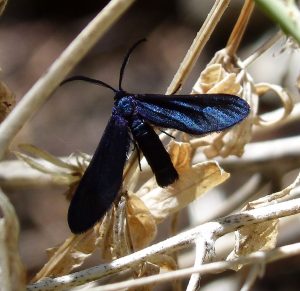
The western grapeleaf skeletonizer
A familiar foe to grape producers is back on the radar as a few reports of grapeleaf skeletonizer are coming out of the Central Coast. The western grapeleaf skeletonizer (WGLS) was first found in California back in 1941 in San Diego. The pest spread through commercial and backyard vines before biological controls were introduced, including A granulosis virus that controlled the skeletonizer so well that it was nearly forgotten. Although the pest was primarily an issue in the Central Valley, reports surfaced back in 2015 of the insect being found in Napa County. UC Cooperative Extension Advisor Surendra Dara reported there have now been some unpublished reports of the insect in organic vineyards and backyard vines along the Central Coast.

Western Grapeleaf Skeletonizer-adult
According to the UC IPM website, adult WGLS moths are metallic bluish or greenish black and fly during the day. The insect has five larval stages and the younger feed on the leaves and turns them brown. The older stages then feed on those leaves, skeletonizing them by leaving only the major veins.
If the granulosis virus is not present in your orchard, Dara is looking at the best ways to control the insect with non-chemical methods. His trial is using several formulations that contain spinosad, two subspecies of Bacillus thuringiensis, and a botanical growth regulator combined with two entomopathogenic fungal isolates native to California. Results varied from the trial, but the spinosad and one of the entomopathogenic fungi combinations performed the best.
Listen to the report.
Image credits: (Feature image) Harrisina metallica, the western grapeleaf skeletonizer/by Whitney Cranshaw, Colorado State University, Bugwood.org, CC BY 3.0 us, Link
(Lower right) Western Grapeleaf Skeletonizer – Harrisina metallica /by gailhampshire from Cradley, Malvern, U.K – , CC BY 2.0, Link










